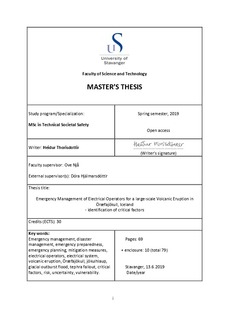| dc.contributor.advisor | Njå, Ove | |
| dc.contributor.author | Thorisdottir, Heidur | |
| dc.coverage.spatial | Iceland | nb_NO |
| dc.date.accessioned | 2019-11-03T08:38:48Z | |
| dc.date.available | 2019-11-03T08:38:48Z | |
| dc.date.issued | 2019-06-13 | |
| dc.identifier.uri | http://hdl.handle.net/11250/2626216 | |
| dc.description | Master's thesis in Risk management and societal safety | nb_NO |
| dc.description.abstract | In Iceland, as in many other countries, the functioning of society is highly dependent on so-called critical infrastructures. These include the electrical system, composed of installations that produce, transmit and distribute electricity to users. To protect the system from harm and secure its continuous operation, the electrical operators must be ready to manage demanding situations and respond to unwanted events. One of the phenomena that can cause a disruptive situation is the ice-covered volcano Öræfajökull. Recent seismic unrest in the area indicates that the volcano is preparing for an eruption. Such an eruption would typically be accompanied by a jökulhlaup (glacial outburst flood) and widespread tephra fallout, both of which could have severe impact on the electrical system and the Icelandic society in general.
The goal of this thesis is to identify critical factors: principles, organizational factors and external influences, that electrical operators should account for in their emergency management for a “large-scale” in Öræfajökull. With the help of 6 sub-questions, the operators´ current form of emergency management and its importance to society was assessed. Important characteristics were detected by comparing this to widely accepted theoretical models. 12 critical factors for the emergency management of the operators were identified. They were sorted into planning factors, organizational factors, factors related to uncertainties surrounding the event and system specific factors. Most of these factors are general and can apply to the emergency management for any catastrophic event affecting the electric system. The factors do not provide detailed guidelines on how electrical operators should handle their emergency management but are viewed as important values, recommendations or principles for the operators to have in mind. | nb_NO |
| dc.language.iso | eng | nb_NO |
| dc.publisher | University of Stavanger, Norway | nb_NO |
| dc.relation.ispartofseries | Masteroppgave/UIS-TN-ISØP/2019; | |
| dc.subject | disaster management | nb_NO |
| dc.subject | emergency preparedness | nb_NO |
| dc.subject | emergency planning | nb_NO |
| dc.subject | mitigation measures | nb_NO |
| dc.subject | electrical operators | nb_NO |
| dc.subject | electrical system | nb_NO |
| dc.subject | volcanic eruption | nb_NO |
| dc.subject | Öræfajökull | nb_NO |
| dc.subject | jökulhlaup | nb_NO |
| dc.subject | glacial outburst flood | nb_NO |
| dc.subject | tephra fallout | nb_NO |
| dc.subject | critical factors | nb_NO |
| dc.subject | risk | nb_NO |
| dc.subject | uncertainty | nb_NO |
| dc.subject | vulnerability | nb_NO |
| dc.subject | beredskap | nb_NO |
| dc.subject | risiko | nb_NO |
| dc.subject | usikkerhet | nb_NO |
| dc.subject | vulkanutbrudd | nb_NO |
| dc.subject | samfunnssikkerhet | nb_NO |
| dc.subject | emergency management | nb_NO |
| dc.title | Emergency Management of Electrical Operators for a large-scale Volcanic Eruption in Öræfajökull, Iceland - identification of critical factors | nb_NO |
| dc.type | Master thesis | nb_NO |
| dc.subject.nsi | VDP::Social science: 200 | nb_NO |
